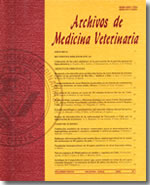Evaluation of binding sperm-exogenous DNA in ejaculate and epididimary porcine spermatozoa
Main Article Content
Abstract
Transgenic biotechnology is a powerful tool for the generation of genetically modified animals with applications in various fields such as veterinary, agriculture and biomedicine. Sperm mediated gene transfer (SMGT) is an interesting tool for animal transgenesis consisting on the intrinsic ability of the spermatic cells to bind and internalize exogenous DNA and allow their transfer into oocytes after fertilization, to become part of the genome of the new embryo. The seminal plasma plays an important role acting as a natural barrier and protecting the spermatozoa from exogenous molecules that could compromise their integrity. So, the epididymal spermatozoa are a valuable model to explore the possible effect of seminal plasma components. The objective of this study was to evaluate the interaction among sperm and transgene using Epididymal (EP) vs Ejaculated (EJ) sperm without seminal plasma. Linealized plasmid (GFP) (5.7 kb) labelled with fluorescein was added (1x108 spermatozoa/ml + 5µg DNA/ml) and incubated at 16 ºC. DNA binding and viability were measured simultaneously by flow cytometry during 120 minutes of incubation. The results showed that EP spermatozoa present a similar DNA-binding ability (12.63 ± 1.23% vs 10.94 ± 1.05%, P = 0.31) and viability throughout the incubation (14.64 ± 0.94% vs 13.42 ± 0.61%, P = 0.23) than EJ. We only detected a greater percentage of living DNA-bound spermatozoa in EP compared to EJ (2.10 ± 0.33% vs 1.05 ± 0.14%, P < 0.01). The DNA-binding was associated mainly to dead sperm or with low viability in both groups (EP: 10.53 ± 1.01% vs EJ: 9.89 ± 0.97%, P = 0.98). These results open new ways to explore and use epididymal spermatozoa in diverse applications (artificial insemination, in vitro fertilization and ICSI) associated with SMGT method.

